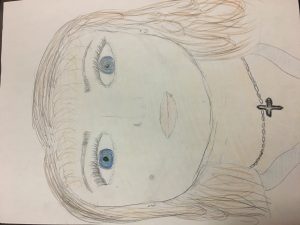
For my last and final blog for this semester I have decided to do a self portrait. I was intrigued by the option because I enjoy drawing, even though I am not at all an artist. I chose to take a somewhat loose interpretation of what a self portrait is supposed to be because, instead of drawing only my features, I added some of my families’ features as well. I did this because I believe I have become who I am due to the influence of the different people in my family.
From my father, I have a strong jaw line and steady eyes, as he is strong and determined. From my mother, I have taken her blue eyes to replace my brown and have added curls to my brown hair and placed a cross around my neck. I feel that, in a way, I have inherited something of these features. I am determined in what I do and, though I am not as strong as my father, I have learned by example how to do things even when they are hard. The blue eyes that I have always wanted are the way my mother looks at the world: clearly and always with kindness. I would like to think that I have some of that. The curls I think represent the ability for her to share what she cares about. The cross is her never-wavering faith that I envy so much.
From my siblings I didn’t add so much to my face but instead I found existing features that represented them. The freckle on my left cheek closest to my eye has always reminded me of my brother because of its relation to theatre in my mind. My brother has a passion for theatre and is majoring in acting here at UBC. My younger sisters are both represented in the drawn details of my eyes. The shading of the irises from dark to light at the center reminds me of the oldest sister. I have connected this feature with her personality because of her fighting, hard-shelled spirit that she presents on the outside, and the softness that she hides. From the youngest I have taken the expression of her wide, innocent eyes always looking with four-year-old curiosity and joy at what is in front of her.
Even though I have described these features in terms of how they relate to my family, I believe every bit of what I have drawn is inside of me as well, to varying degrees. These features as I have depicted them reveal how I define myself in the world, and disclose the influences that make me who I am today.